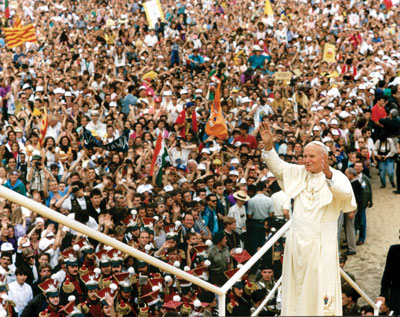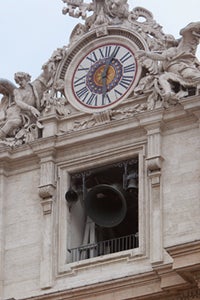Helping Catholic Parish Ministers unlock their ministry and defeat burnout forever. ❤️🔥
Fr. Mitch Pacwa Epic Debates
[youtube=http://youtu.be/E5VDG2nb5h0] I want to make sure all you great Catholics out there are aware of what is, in my opinion, a few of the best Catholic debates of all time - Fr. Mitch Pacwa on the John Ankerberg Show.
I learned a heck of a lot from Fr. Mitch Pacwa watching him handle these tough Protestant issues on the John Ankerberg Show, with a less-than-unbiased moderator. Fr. Pacwa is so precise and clear; in the words of one of my professors "He's got a brain the size of France."
There are too many videos to post them all here, but to get the rest, go to youtube and type "Fr. Mitch Pacwa debate".
Go learn something!
[youtube=http://youtu.be/EU2K9HQFxso]
Fr. Mitch Pacwa Debates Protestant about Mary
[youtube=http://youtu.be/cOVWL2AHh18]
### What are your favorite Catholic debates? Any other good ones on youtube?
+JMJ
U.S. Postal Service and Relevant Evangelization

In 2009 the United States Postal Service was struggling financially, as it still is today. After noticing stamps of Elvis Presley sold better than stamps of Millard Fillmore (who?), the USPS decided to add more contemporary characters to their 2009 lineup of sea kelp and the state of Alaska (yay sea kelp!).
At the suggestion of a citizens panel, the USPS printed 1 billion (1,000,000,000) commemorative stamps with portraits of Simpsons characters: Homer, Marge, Maggie, and Baby Lisa.
It seems like a great idea and no brainer: millions of Americans watch The Simpsons, and the merchandise for the cartoon show is a hundred million dollar industry. If Elvis sells better than Millard Fillmore, than Homer should sell better than Elvis. Homer is more relevant to more people.
Between 2009 and 2010 the USPS sold only 318 million Simpsons stamps of the one billion they printed. That leaves 682 million unbought and costing the USPS $1.2 million during a period of already deep debt. What happened?
The appearance of a culture is not the values (of the people) of a culture, even though they are related.
This needs explaining, because it is a subtle concept and the difference is nuanced.
Millions of Americans watch the Simpsons. And the USPS was tempted to believe that if they translated the appearance of that culture into the snail mail world, the audience would follow and buy Simpsons stamps.
But the type of people who watch the Simpsons are not people who value sending letters in the mail, or who even receive letters in the mail. The people who are part of a culture that watches the Simpsons place little to no value on physical mail. They are a younger generation brought up on email and texting. The visual trappings of the culture are not most important, the values of the people of the culture are most important.
The word relevant, according to Merriam Webster, is defined:
Relevant: having significant and demonstrable bearing on the matter at hand
All the trappings of any culture - hipster, indie, goth, rock and roll - are the outward expressions of inwardly held values and convictions. They are outward expressions of a perspective on the matters at hand - the matters that are most important to that particular culture.
Roots and Veneer
The Church wisely instructs us in a document specifically about evangelization:
"...what matters is to evangelize man's culture and cultures (not in a purely decorative way, as it were, by applying a thin veneer, but in a vital way, in depth and right to their very roots),... always taking the person as one's starting-point and always coming back to the relationships of people among themselves and with God." Evangelii Nuntiandi #20
If the pastor of a Church decides to start dressing like this:
for the sake of being "relevant" to hipsters, but never has any significant bearing on the matters most important to hipsters - nonconformity, radical independence, and shameless self-expression - then he is just applying a thin veneer to the Gospel. The pastor who does this is not taking the person as the starting point, but the clothes and appearance as the starting point of evangelization.
The appearance of a culture originates in the values the people of that culture are most strongly rooted in. Sure there are phoneys and fakes, but the core of any culture is born in a value held by a person. Any attempt at evangelization must take into consideration the deeply rooted values of the people being evangelized.
How to Be Relevant
As a twenty-four year old baby-faced youth minister who wears jeans, I get tired of people over the age of 30 telling me again and again "It's so good you are a youth minister, because you are young and relevant to the kids." I know plenty of people my age who would NOT be relevant to high school teens, and I know plenty of people over 50 who are extremely relevant to high school teens.
Just for one small example: hundreds of thousands of youth flocked to World Youth Days, wherever they were held, to see a 70+ year old Pope who captured the hearts of an entire generation of young Catholics. I would consider Pope John Paul II pretty relevant.

What is the secret to coming across as relevant when speaking to teens, hipsters, the shuffleboard club, or democrats? Having significant and demonstrable bearing on the matters at hand, that is, the deep rooted values these people hold.
If I talk to high school teens about the intricacies of mutual funds using their lingo and wearing their clothes and referencing their culture, that is not relevant. If I am 60 years old and talk about how much it sucks to breakup with your boyfriend, THAT is relevant.
And when you address the deep rooted values and concerns of people, you open up an opportunity to present them with a truth they are hungering for, a truth that transcends cultures and is not only rooted in Jesus Christ, but IS Jesus Christ.
This is how we make Jesus relevant.
"...man always exists in a particular culture, but it must also be admitted that man is not exhaustively defined by that same culture. Moreover, the very progress of cultures demonstrates that there is something in man which transcends those cultures. This "something" is precisely human nature: this nature is itself the measure of culture and the condition ensuring that man does not become the prisoner of any of his cultures, but asserts his personal dignity by living in accordance with the profound truth of his being" Veritatis Splendor #53
How to Make a Catholic Meme
 So you're upset because of something you read on the internet, or one of your friends is spewing hate against Mama Church, and you wants to show them the what for in a punchy, trendy, hip sort of way. What's an internet new evangelist to do?
So you're upset because of something you read on the internet, or one of your friends is spewing hate against Mama Church, and you wants to show them the what for in a punchy, trendy, hip sort of way. What's an internet new evangelist to do?
A good (and probably a little sarcastic) ol' fashioned meme is the way to go (pronounced "meem" like team. Not "mee mee" like what you call your grandmother). They're like the religious tracts your protestant friends used to hand out, except without all the pages, and funnier.
So you went on catholicmemes.com looking for the perfect one, and after 8 hours of browsing, you still haven't found the perfect fit. Well, if no one has done it right, you gots to do it yourself.
MAKE YOUR OWN CATHOLIC MEME
Step 1: Look for a background picture.
Go to google and find a good picture. You can use any picture, or you can use an existing popular meme picture.
Get a BIG picture. The bigger the picture the better. BIGGER. We want everybody and the people next to them to see this bad boy. We're talking fill-up-an-entire-facebook-news-feed-make-your-smartphone-explode kinda big.
Jackie Chan is a good place to start.
 Step 2: Copy the photo into paint.
Step 2: Copy the photo into paint.
Open up paint. (Sorry mac users, I pretend you don't exist)
 Whoops. Um, just ignore that... awkward....
Whoops. Um, just ignore that... awkward....
There we go.
Step 3: Add text.
Think up a really pithy and incendiary message to get your Catholic point across. It's got to have some bite, and maybe expose some logical fallacies. Put it in big chunky white letter with the caps lock on. WHEN THINGS ARE TYPED IN ALL CAPS PEOPLE PAY ATTENTION. 
Whoa there Kirk Cameron, too incendiary. First rule of fight club, have some class. Name calling won't work. Point out the insanity of a situation instead.
Step 4: Make it public.
Add the fruit of your labors to your favorite social networks. I suggest Facebook, Twitter, and Reddit for starters. The Reddit beasts in the Catholicism group love them some memes. While waiting for people to comment/like/share/retweet your creation, rejoice and listen to some o' this because you have done your part to spread truth in a culture of lies.
Make your own!
Do your part! Take part in the New Evangelization by spreading truth to the 10-second-attention-span-facebook-browsing culture, the Pope will thank you.
No really, make a meme and send it to the Pope. #OnlythePopeUnderstandsMe
Or you could just go to www.quickmeme.com/make/ and make one on there or whatever....
Bob Rice: "How the Catechism Made Me Catholic"
 Here is a witness from Bob Rice about how his life was changed by reading and praying through the Catechism of the Catholic Church.
Here is a witness from Bob Rice about how his life was changed by reading and praying through the Catechism of the Catholic Church.
"I remember looking down and seeing blood on my hands. My head was still spinning from the line of cocaine that I snorted in the bathroom. The prostitute I just had sex with was face down on the bed, murdered. Did I do it? I couldn’t remember. I heard sirens outside and footsteps running up the stairs to my apartment. That was the moment that I realized I needed a Savior. I needed Jesus.
Okay, none of that is true."

"Truth be told, I have a very boring conversion story: I always loved Jesus. And then I loved Him more.
I was the good kid. Never drank. Never did drugs. Knew to save sex for marriage. In fact, I lived in fear of letting others down: my parents, my teachers, or even God. I was a straight A student and prayed every night.
So it might not be a surprise when I tell you that one of the most exciting moments in my conversion is when I did something that many consider boring:
I read the Catechism."
-->Read the rest of the article here, and then go read the Catechism.<--
Two practical takeaways from his post:
+ If the Catechism seems overwhelming, try committing to reading one "In Brief" summary at the end of each section in the Catechism every day.
+ If you need an easy place to start, the fourth pillar of the Catechism on prayer is a good place.
_________________________________________________________________
Bob was my professor for many many classes while I attended Franciscan University, and I have to thank him for forming me as a Catholic, catechist, and youth minister, (and actually as a father too) through his deep love for Jesus, his witness as a father, and his love for the Catholic Church. Maybe one day I will write a post about all the ways he has so tremendously impacted me, but it would be too sappy.
Thanks Bob.
The Mass: A Model for Personal Prayer
 St. John of the Cross Statue by Magdeleine Weerts
St. John of the Cross Statue by Magdeleine Weerts
What should the rhythm of our personal prayer look like? Is prayer just one action, or a movement toward God with a beginning, middle, and end? The Church gives us an answer in the Catechism of the Catholic Church. This rhythm is akin to the Mass and can help us enter into prayer more easily and develop a habit of prayer that moves us towards God.
Personal Prayer and the Mass
If we look in the fourth pillar of the Catechism on prayer (remember, the Catechism is split into four pillars - Creed, Sacraments, Morality, and Prayer) especially the section on contemplative prayer, the Catechism makes the connection between contemplative prayer and the Mass:
"Entering into contemplative prayer is like entering into the Eucharistic liturgy" (paragraph 2711).

Remember, contemplative prayer is not something only reserved for Nuns or levitating Saints, contemplative prayer is nothing more than "a close sharing between friends" and "a gaze of faith, fixed on Jesus" meant for every Christian.
As we'll see in the Catechism, there are four movements to this rhythm of prayer: GATHER, RECOLLECT, ABIDE, ENTER.
Let's unpack the rest of paragraph 2711 to find a rhythm of personal prayer and its connections to the Holy Sacrifice of the Mass.
GATHER

"Entering into contemplative prayer is like entering into the Eucharistic liturgy: we "gather up" the heart, recollect our whole being under the prompting of the Holy Spirit, abide in the dwelling place of the Lord which we are, awaken our faith in order to enter into the presence of him who awaits us." CCC 2711 __________________________________________________________________________
At the beginning of Mass, we begin with the sign of the Cross and with an opening prayer, called the Collect. Thus the beginning of Mass is a call to gather ourselves up from the world and reorientate ourselves in relation to Christ.
When I first walk into Mass, there are a thousand thoughts and distractions going through my head, as when I first begin to pray. At the beginning of prayer and the Mass, the first step is gathering our attention and thoughts and disengaging from the world around us (like Kevin Costner in that baseball movie...) so that we can place ourselves in the presence of God. Making the Sign of the Cross is a good way to begin prayer because it reminds us why we pray and to whom we pray.
St. Francis de Sales offers four ways of disengaging from the world and placing ourselves in the presence of God in the Introduction to the Devout Life:
1) Realizing God is omnipresent; that God is in everything and everywhere 2) Realizing God is in a very special manner in your heart and the depth of your spirit 3) Realizing God looks down on us from heaven, especially those in prayer 4) Imagining Jesus Christ in his humanity as though he were near us or next to us
RECOLLECT

"Entering into contemplative prayer is like entering into the Eucharistic liturgy: we "gather up" the heart, recollect our whole being under the prompting of the Holy Spirit, abide in the dwelling place of the Lord which we are, awaken our faith in order to enter into the presence of him who awaits us." CCC 2711 _________________________________________________________________________
At the beginning of Mass after the opening prayer is the Penitential Rite, where we acknowledge our sins and repent of them, followed by the Gloria praising God for his mercy and love.
Likewise the next phase of prayer means being honest with ourselves and with God about the state of our our soul and our heart. "We do not know how to pray as we ought" (Romans 8:26), but if we ask, the Holy Spirit teaches and guides us in prayer to acknowledge and relate to God truthfully who we are, where we have been, our thoughts, desires, baggage, and even our recent sins and shortcomings.
A few paragraphs back, the Catechism explains contemplative prayer in the words of St. Teresa: "Conteplative prayer in my opinion is nothing else than a close sharing between friends" (Catechism 2709). It's like answering the question "How ya' doing?" from a friend you haven't seen in awhile.
ABIDE

"Entering into contemplative prayer is like entering into the Eucharistic liturgy: we "gather up" the heart, recollect our whole being under the prompting of the Holy Spirit, abide in the dwelling place of the Lord which we are, awaken our faith in order to enter into the presence of him who awaits us." CCC 2711 __________________________________________________________________________
During Mass, we abide in the presence of God and listen to Him. We hear His voice in the Old Testament, His glory in the Psalms, and encounter Him in the flesh in the Gospels, all during the Liturgy of the Word.
After coming to God in prayer and talking to Him about what is honestly going on in our heart and in our lives, the conversation begins to turn over to God. Just like on the road to Emmaus (Luke 24:13-35), after we unload what is on our hearts we give God the opportunity to respond to us. This is when true contemplative prayer can begin.
In the following paragraphs of the Catechism, it explains that "contemplative prayer is hearing the Word of God." (Catechism 2716) In order for us to hear the Lord, we need to be patient and wait on Him (Psalm 27:14). I can't stress enough how important interior silence is for prayer. How can we hear God speak to us if we never shut up? Don't be afraid that you are doing nothing by sitting in silence this way. "Contemplation is a gaze of faith, fixed on Jesus." (Catechism 2715). As long as you are focused on God, you are praying. Sometimes God speaks words to your heart, sometimes He sends you peace, sometimes He may just be present with you in that moment, pouring out His love on you.
ENTER

"Entering into contemplative prayer is like entering into the Eucharistic liturgy: we "gather up" the heart, recollect our whole being under the prompting of the Holy Spirit, abide in the dwelling place of the Lord which we are, awaken our faith in order to enter into the presence of him who awaits us." CCC 2711 __________________________________________________________________________
The most intimate moment of Mass happens when we receive our Lord in the Eucharist and come into communion with our God.
Contemplative prayer is a gift beyond words. Initiated by God, we become caught up in the life of the Trinity and are led to share in the love between the Father and the Son. There is no way to make this happen, we must abide in God's presence and wait for Him to bring us into communion with Him. But when this gift does occur, when God allows us to enter into His mystery and experience a foretaste of heaven, it is like an blaze of faith, hope, and love being ignited in your chest!
It's That Easy! (Sort of)
Prayer is hard work, especially contemplative prayer. Remember, God is the one who initiates contemplative prayer, it is a gift and we can only patiently wait with a loving gaze fixed on Him. Realize that it will be hard at the beginning, but if we put in even the smallest effort to reach out to God in love, God graciously reward us. Set up a time to regularly practice praying in this way everyday and you will begin to experience the deep love, joy, and peace of a life in intimate relationship with God.
A Rhythm of Prayer from Catechism 2711 "Entering into contemplative prayer is like entering into the Eucharistic liturgy: we "GATHER up" the heart, RECOLLECT our whole being under the prompting of the Holy Spirit, ABIDE in the dwelling place of the Lord which we are, awaken our faith in order to ENTER into the presence of him who awaits us. We let our masks fall and turn our hearts back to the Lord who loves us, so as to hand ourselves over to him as an offering to be purified and transformed."
+JMJ
###What do you think? Was this helpful? Let me know in the comment box. God Bless!
Dr. Brant Pitre Talk on the Jewish Roots of the Eucharist
[youtube=http://www.youtube.com/watch?v=NYDSPcEoC74]
How would ancient Jews have understood the Eucharist?
This mind blowing talk by Dr. Brant Pitre on the Jewish roots of the Eucharist answers that question. Prepare to have your little Catholic brain explode - you'll never look at the Eucharist the same again.
Just a little teaser for you as I read and write a super-review of his book "Jesus and the Jewish Roots of the Eucharist".
Creation of the Universe and You
[youtube=http://youtu.be/N_ZjaZmjImE] Hat tip to Brandon for linking to this well produced and simple video put out by the Diocese of Wheeling-Charleston as part of their new VCAT project. The film series walks you through the Catechism using engaging youtube videos released every month during the Year of Faith.
I love this video. It captures your attention with the retro and cheesy tv production of the 1970's and is super smooth and simple, driving home a big message: "This world is not an accident. You are not an accident. You were made by God. You were made FOR God. Not because of luck, but because of love."
I would love to see more videos in the same style and genre: "Mr. Smith's Catechism Class" from the 60's. But, you know...minus all the poor catechesis of the 60's...
Dual Wielding the Bible and the Catechism
If you want to be a good Catholic, you gotta read your Bible. But the Church advises us: "sacred tradition, Sacred Scripture and the teaching authority of the Church... are so linked and joined together that one cannot stand without the others" (Dei Verbum Par. 10).
Combining Sacred Scripture and Sacred Tradition is a deeply Catholic way to read the Bible, and a powerful way to dive deep into our Faith. If Sacred Scripture and Sacred Tradition are so intimately linked, reading them in light of one another is drinking deeply from the wells of faith the Church has to offer. (What a great idea for the Year of Faith!!!)
But how can we do this easily and effectively?
The following is a method of doing just that. I'll be walking you through how to break open Scripture with the eyes of the Church using the catechism and its index of citations (mentioned in the post how to use the catechism). So grab The Word and a catechism and let the dual wielding begin...
The Bible
The Gospel reading a few days ago is taken from Luke 19:1-10 (read it online here) and recounts the story of the meeting of Jesus and Zacchaeus, the tax collector. Zacchaeus hears Jesus is coming to Jericho and "was seeking to see who Jesus was". Being a short fellow (for some reason I picture him as Danny Davito) Zacchaeus climbs a tree to get a glimpse of Jesus. As Jesus passes by he calls out to the man in the tree, announcing he will stay at Zacchaeus' house. Zacchaeus comes "down quickly and received him with joy". The now repentant tax collector vows to give half his possessions to the poor and to repay those he has wronged four times over. Jesus concludes "Today salvation has come to this house because this man too is a descendant of Abraham. For the Son of Man has come to seek and to save what was lost.”
Reading this passage, there are a few questions that come to mind. What does it mean for Zacchaeus that Jesus wants to stay at his house? And why does Zacchaeus have such a strong reaction to Jesus? It seems there are some things going on here that might not be obvious to us.
The Catechism
Using the index of citations at the back of the catechism we can look up where in the sections of the catechism this episode with Jesus and Zecchaeus is cited.
If you can't find the index of citations, look for the last paragraph of the catechism, 2865. It is right after it.
There are four citations of this passage throughout the catechism. One references the entire passage of Luke 19:1-10, and the other three reference two lines from this passage. The catechism cites all of Luke 19:1-10 in paragraph 2712, so let's start there to see how the Catechism uses this passage to explain the faith to us.

Catechism #2712 "Contemplative prayer is the prayer of the child of God, of the forgiven sinner who agrees to welcome the love by which he is loved and who wants to respond to it by loving even more. (Luke 19:1-10) But he knows that the love he is returning is poured out by the Spirit in his heart, for everything is grace from God. Contemplative prayer is the poor and humble surrender to the loving will of the Father in ever deeper union with his beloved Son."
Contemplative prayer? What is going on here? At first glance I was thoroughly confused too. But confusion is a good thing. Confusion means we don't understand, which means we could be staring at an opportunity to learn. If you only ever read what you understand you may gain information, but you will never gain understanding.
Sweet Symphony
So how does the catechism help us understand the story of Zacchaeus better? Let's look at three of the catechism paragraphs that cite this passage and see if we can make some better sense of what is going on.
If we read through paragraph 2712 it is clear that Zacchaeus is "the forgiven sinner who agrees to welcome the love by which he is loved". The love by which Zacchaeus is loved is Jesus, who desires to stay with Zacchaeus.
We can look to catechism paragraph 1443 which explains that Jesus "not only forgave sins, but also made plain the effect of this forgiveness: he reintegrated forgiven sinners into the community of the People of God from which sin has alienated or even excluded them."
So Zacchaeus, the tax collector, was a man probably alienated from the community of the People of God because of his sins. But how is staying at someone's house a great act of love on Jesus' part?
If we continue reading we find the answer. Jesus is offering Zacchaeus an act of reconcilliation by offering to not just stay with him, but to dine with him: "Jesus receives sinners at his table, a gesture that expresses in an astonishing way both God's forgiveness and the return to the bosom of the People of God."
We can even see that Zacchaeus' strong reaction is a just action. In paragraph 2412 the catechism explains: "Jesus blesses Zacchaeus for his pledge: 'If I have defrauded anyone of anything, I restore it fourfold." Those who, directly or indirectly, have taken possession of the goods of another, are obliged to make restitution of them, or to return the equivalent in kind or in money...".
Wrapping It Up
These three paragraphs from the catechism shed some light on the story of Zacchaeus and Jesus.
By offering to dine at the table of Zacchaeus (Catechism 1443), Jesus gives Zacchaeus an opportunity to be reconciled with God and brought back into the community of the People of God.
Zacchaeus is not just showboating when he vows to give to the poor and repay those he has wronged. He is being offered love by Jesus and is so overwhelmed by what is being offered to him that he desires to respond to it by loving even more (Catechism 2712). This is an model of the dynamics of prayer.
Not only does Zacchaeus reconcile with those he has wronged, he goes above and beyond the demands of justice (Catechism 2412) and pledges to repay his debtors fourfold and to give half of his possessions to the poor.
Prayer
After reading this passage in Scripture and the paragraphs in the catechism, some things about prayer really started to click. Prayer is a response of love to God. In prayer we begin by realizing how much love the Father has for us, to take notice of us and offer us reconciliation like Jesus offered Zacchaeus. And we respond "quickly and [receive] him with joy", being given a child-like desire from the Holy Spirit. We begin to desire the impossible - to love God even more than He loves us.
And not only do we enjoy the love of God, and enjoy giving love back to him but, like Zacchaeus, it then spills over into our life with our neighbors. After experiencing such a deep and forgiving love, I am compelled to reconcile with my neighbors.
Reading Scripture with the catechism gave me a profound insight into the life of prayer and relationship with God. I am sure this image of Zacchaeus' impossible thankfulness and surge of the heart will be in my mind every time I pray for the next few months.
CHALLENGE
I want you to try praying with Scripture and the catechism this way. All you need is twenty minutes, a Bible, and a catechism for an intense prayer time dual wielding Sacred Scripture and Sacred Tradition.
Step 1) Go somewhere you can pray. Bring a Bible and a Catechism.
Step 2) Take a passage from Scripture, or even just one line from Scripture, and look it up in the index of citations in the catechism.
Step 3) Prayerfully read through all the referenced passages. If there are too many, then either narrow down the Scripture or focus on any references in the catechism to the passage that don't make sense right away. Prayerfully reread them and ask God to teach you.
Step 4) Let me know in the comment box (or on your own blog!) your experience or what God revealed to you by praying Scripture with the catechism this way.
Some Passages to Try
I haven't tried these passages, but I would love to in the future. If you can't think of a place to start, start with these.
John 6:54 Luke 1:37 Jeremiah 31:31-34 Genesis 3:15 Luke 3:21 Isaiah 43:1-7
#### I challenge you to try praying with Scripture and the catechism this way. Follow the steps and leave a comment telling me how it went. If you have any hang ups, let me know and I'll try to help.
+JMJ
New Evangelization Must Be Cheese
 The New Evangelization has been called many things, but cheesy is not one of them, and this is a shame. If the New Evangelization is to accomplish the task of re-evangelizing the cultures and communities of today, then the New Evangelization should be more like good cheese.
The New Evangelization has been called many things, but cheesy is not one of them, and this is a shame. If the New Evangelization is to accomplish the task of re-evangelizing the cultures and communities of today, then the New Evangelization should be more like good cheese.
“In each inn the cheese was good; and in each inn it was different.”
G.K. Chesterton wrote some interesting things about cheese after a trip giving lectures around England. During his travels he lunched in several roadside inns across England that offered nothing but bread and cheese. He found in these cheeses a quality he describes as “the very soul of song.”
Chesterton saw in the cheeses two things:
1) Each cheese was local and therefore diverse, taking on the flavor of the surrounding culture.
The “noble” cheese of Wensleydale was a different happy expression of cheese than that of the cheese of Cheshire, or the cheese in Yorkshire, or the cheese in any of the inns. Chesterton believes that universal truths are best expressed through customs and civilizations when they are living, varying, and diverse. The cheese becomes exquisite because it communicates truth and beauty in a way that is in touch with reality and its local surroundings. The divine and universal idea of cheese takes on the human nature of the town and the people that labored to lovingly produce the cheese.
“Bad customs are universal and rigid, like modern militarism. Good customs are universal and varied, like native chivalry and self-defence… But a good civilization spreads over us freely like a tree, varying and yielding because it is alive. A bad civilization stands up and sticks out above us like an umbrella - artificial, mathematical in shape; not merely universal, but uniform.”
2) Each cheese was the object of a loving art, and therefore was very high quality.
"Now, it is just here that true poetic civilization differs from that paltry and mechanical civilization that holds us all in bondage." Chesterton noticed that industrial cheese found in a large city, much like soap that is mass produced and sent all around the world, did not have the same eclectic and local flavors of the cheese he encountered at the inns and was not very good either.
 Not only did the cheeses of the city lack an exquisite taste, but the people that served the city cheese took no pride nor showed any reverence toward their cheese. Chesterton laments about a waiter that served him cheese on what was basically a cracker. After dining on the magnificent cheese of the inns served with what most likely was hearty breads, Chesterton was more than a little upset to get a bland cheese on a lifeless cracker.
Not only did the cheeses of the city lack an exquisite taste, but the people that served the city cheese took no pride nor showed any reverence toward their cheese. Chesterton laments about a waiter that served him cheese on what was basically a cracker. After dining on the magnificent cheese of the inns served with what most likely was hearty breads, Chesterton was more than a little upset to get a bland cheese on a lifeless cracker.
“I addressed the waiter in warm and moving terms… I asked him if, when he said his prayers, he was so supercilious as to pray for his daily biscuits. He gave me generally to understand that he was only obeying a custom of Modern Society. I have therefore resolved to raise my voice, not against the waiter, but against Modern Society, for this huge and unparalleled modern wrong.”
 Industrialized Ministry
Industrialized Ministry
For too long we have been searching for an answer to the task of evangelization that is more like a microwave dinner than well made cheese. We want to take it out of the box, plug it into the parish, let it run, and reap the rewards of a vibrant ministry. We want a one-size-fits-all answer to evangelization that requires little thinking, no volunteers, and little effort.
There is a place for these resources, and they are a gift to the Church, but they should not be used as crutches or be the primary thrust of a parish's evangelization efforts.
Good Old New Evangelization Cheese
1.) Evangelization should be local and therefore diverse, taking on the flavor of the surrounding culture.
Christ was one man, and yet he finds infinitely varied and true expressions in the lives of the Saints. From the poor St. Francis to the richer St. Thomas Moore. From the silent and anonymous Benedictines hidden from the world in monasteries, to the preaching Domincans.
People want to encounter a living and active faith, not one that is recorded on dvd's and mass produced somewhere in Spain and shipped all over the world. These resources are great to supplement a parish, but they should not be the sole expression of a living and evangelizing culture of a parish.

We need to make each of our Churches a Saint. Our parish community should become a unique expression of Jesus Christ lived out in a life-giving and profoundly beautiful way. Our individual parishes need to engage and transform the surrounding culture into something sacred, something worth attracting the attention of modern man who is so jaded by industrialized, commercialized, and mass produced ideas.
Where have all the local celebrations and popular devotions gone? Most parishes are named after a Saint, but that is as far as the Saint's influence goes. Where is the loving expression of unique devotion? We have lost our culture, we have begun to mass produce our cheese. Where is the St. Francis Parish making fools for Christ? Where is St. Joseph's Parish devoted to producing holy fathers? Where is St. Stephen's Parish celebrating martyrs all year long and lighting a fire of zeal in its parishoners who would rather be stoned than betray their Lord?

What happened to Corpus Christi processions at Corpus Christi parishes? Why doesn't the Church in the country become the greenhouse of holy farmers? Why doesn't the Church in the city produce another Mother Teresa? Do you have a lot of doctors and nurses in the area? Why not start traditions and devotions to St. Gianna?
How often do we address the unique needs and capacities of our community members before trying to figure out how to minister to them? Do we send out surveys asking what they desire to learn more about, or what questions or problems the parish as a whole are facing?
2.) Evangelization should be the object of a loving art, and therefore high quality.
If we have the boldness to believe that we are involved in the sacred and holy task of transmitting Christ to others, we need to really reevaluate how we are accomplishing this. Do not make bad cheese, and do not serve Christ up on a cracker.
We need to have a more profound and deep reverence for what it is we are doing when we attempt to evangelize. Jesus Christ deserves much more than a clip art presentation thrown together at the back of the social hall.

We need authentic and beautiful culture. Why not encourage local art at our parish? Why not devote time and energy into fostering local spirituality: a spirituality of the fields, of the hills, of the city, of the farmer, of the rich, of the poor, of the community in your specific area that is more than just a thrown together prayer service, but is the work of a loving art?
The methods and modes we use to evangelize should be crafted and perfected - the object of a loving art. The way we speak, write, and advertise should all be approached with a awed humility. We are announcing the Most High, we should remember that we share this task with angels.
Prudence and Zeal
I won’t shy away from saying these things, even though some will read this and think “Yes, we need banjos in Mass and a kid with a streamer to dance during Father’s homily, and clowns, lots of clowns!” I am not advocating for the type of unique expression that is a mutilation of the truths of the faith. Zeal for authenticity and vibrancy must not mean the sacrifice of orthodoxy and universality.
I will leave you with the cheesy words of the Church:
From the Conclusion of the recent Synod on the New Evangelization
No one person or group in the Church has exclusive right to the work of evangelization. It is the work of ecclesial communities as such, where one has access to all the means for encountering Jesus: the Word, the sacraments, fraternal communion, charitable service, mission.
In this perspective, the role of the parish emerges above all as the presence of the Church where men and women live, “the village fountain”, as John XXIII loved to call it, from which all can drink, finding in it the freshness of the Gospel. It cannot be abandoned, even though changes can require of it either to be made up of small Christian communities or to forge bonds of collaboration within larger pastoral contexts. We exhort our parishes to join the new forms of mission required by the new evangelization to the traditional pastoral care of God's people. These must also permeate the various important expressions of popular piety.
40. The obvious importance of the content of evangelization must not overshadow the importance of the ways and means. This question of "how to evangelize" is permanently relevant, because the methods of evangelizing vary according to the different circumstances of time, place and culture, and because they thereby present a certain challenge to our capacity for discovery and adaptation.
63. The question is undoubtedly a delicate one. Evangelization loses much of its force and effectiveness if it does not take into consideration the actual people to whom it is addresses, if it does not use their language, their signs and symbols, if it does not answer the questions they ask, and if it does not have an impact on their concrete life. But on the other hand, evangelization risks losing its power and disappearing altogether if one empties or adulterates its content under the pretext of translating it
+JMJ
Does Jesus Hate Tattoos?
 Check out this great article on tattoo taboos, Leviticus, and the tattoo on Jesus' thigh by the world renowned Nate Addington.
Check out this great article on tattoo taboos, Leviticus, and the tattoo on Jesus' thigh by the world renowned Nate Addington.
"Every so often someone, usually of the elderly female variety, will raise one of three standard objections to tattoos.
1.) Someday you are going to regret that
2.) When you are old those are going to look horrible
and of course
3.) You know God does not like tattoos, it just isn’t Christian.
To which I always respond that I have never regretted, even for a fraction of a millisecond, any of my tattoos. Furthermore, when I am old and orchestrating wheelchair street races in the local nursing home, me and all my geriatric buddies will stretch out our wrinkled skin, take a shot of our prune juice, and share the stories of our tattoos while reminiscing about the good ole’ days when we were young and gas was only $4.00 a gallon."













